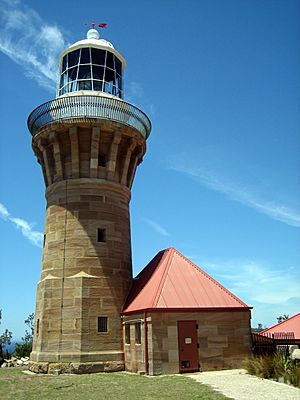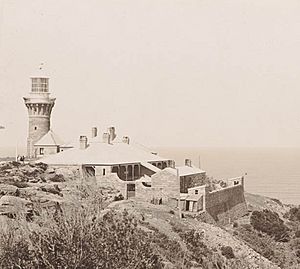Barrenjoey Head Lighthouse facts for kids
 |
|
| Barrenjoey Head Lighthouse | |
|
|
|
| Location | Broken Bay, Sydney, New South Wales, Australia |
|---|---|
| Coordinates | 33°34′49″S 151°19′47″E / 33.580147°S 151.329796°E |
| Year first lit | 1881 |
| Automated | 1932 |
| Construction | Sandstone tower |
| Tower shape | Cylindrical tower with balcony and lantern |
| Markings / pattern | Unpainted tower and white lantern room |
| Height | 20 metres (66 ft) |
| Focal height | 113 metres (371 ft) |
| Original lens | 2nd order Chance Brothers Fresnel lens |
| Intensity | 75,000 candela |
| Range | 19 nautical miles (35 km; 22 mi) |
| Characteristic | Fl (4) W 20s. Visible in sector |
| Admiralty number | K2702 |
| NGA number | 111-6156 |
| ARLHS number | AUS-005 |
The Barrenjoey Head Lighthouse is a famous lighthouse located on Barrenjoey Headland in Palm Beach, Australia. It's a very old and important building, listed on the New South Wales State Heritage Register. The lighthouse was designed by James Barnet, a well-known architect, and built by Isaac Banks.
This lighthouse is the third one built on the Barrenjoey headland. It was finished in 1881. Today, the light works automatically, meaning no one needs to be there to turn it on. The NSW National Parks & Wildlife Service looks after the buildings.
Contents
History of Barrenjoey Lighthouse
Early Days and First Lights
The land around Barrenjoey Headland was originally home to the Guringai people. They used the area for many years. Later, in 1788, Governor Phillip named the headland "Barrenjuee" after an Aboriginal word for a small wallaby.
Broken Bay was a busy port because of trade along the Hawkesbury River. Ships carried goods and people, and the river was important for farming. To help ships navigate, a wooden hut was built on Barrenjoey in 1843. A fire basket was sometimes lit there in bad weather.
The first official lighthouses were two wooden buildings called the Stewart Towers. They started working in 1868. These were temporary lights to guide ships. Broken Bay was a safe place for ships to hide during storms. It was also important for barges carrying food to Sydney.
Building the Permanent Lighthouse
In 1873, officials decided a single, permanent lighthouse was needed. Many ships had crashed in the area, showing how important a light was. The current lighthouse was designed by James Barnet. It was completed and first lit on 1 August 1881.
The lighthouse and its buildings were made from local Hawkesbury sandstone. This stone was dug right from the headland itself. The original light was a steady red light. The tower is round and has a balcony around the top.
The lighthouse cost a lot of money to build. It stands 113 metres (371 ft) (about 371 feet) above the sea. This means its light can be seen up to 19 nautical miles (35 km; 22 mi) (about 35 kilometers) away.
How the Lighthouse Changed Over Time
In 1900, a fire happened in the oil house next to the lighthouse. Luckily, the flames were put out before they reached the main tower.
In 1932, the Barrenjoey Lighthouse became automatic. It started using an acetylene gas light. This light turned on and off by itself using a special "sun valve." This meant lighthouse keepers were no longer needed to operate the light.
Later, in 1972, the lighthouse was updated again. It was changed to use electricity. The new electric lamp was much brighter, making the light even stronger.
After the lighthouse became automatic, the keepers moved out. The buildings were empty for a while and got damaged. But in the 1950s, people started leasing the cottages. They have been looked after and restored since then.
The Barrenjoey Head Lighthouse has also become famous from TV. It's often seen in the Australian TV show Home and Away.
Lighthouse Keepers and Their Homes
The lighthouse complex includes the main lighthouse tower. It also has a large cottage for the head keeper and two smaller cottages for assistant keepers. These homes are also built from the same local sandstone.
Many people worked as lighthouse keepers at Barrenjoey. They lived on the headland with their families. Their job was to make sure the light was always working to guide ships safely.
Here are some of the keepers who worked there:
- George Mulhall (1881–1885)
- George Mulhall, Jnr. (1881?–1891)
- Robert William Russell (1910–1920 and 1925–1931)
- Richard Sullivan (1921–1925)
- John Berryman (1931–1932)
After 1932, the lighthouse became automatic. The cottages were empty for a long time. From 1960 to 1997, the cottages were leased out to people. Since 1997, the NSW National Parks & Wildlife Service has looked after them. They have worked to restore the cottages and the walking paths around the lighthouse.
One person, Jervis Sparks, lived in one of the assistant keeper's cottages for 31 years. He helped restore it and even wrote a book about the lighthouse. He and his wife were like unofficial caretakers of the area.
International Lighthouse Weekend
Every year, a group called the Manly-Warringah Radio Society celebrates International Lighthouse and Lightship Weekend. They set up a special radio station at the Barrenjoey lighthouse. Their goal is to teach people about lighthouses and how important they are. They also use amateur radio to talk to other lighthouses around the world.
What Barrenjoey Headland is Like
Location and Scenery
Barrenjoey Headland sticks out into Broken Bay. It's a beautiful spot with amazing views. To the north, you can see Bouddi National Park. Lion Island is also visible nearby. To the west, Ku-ring-gai Chase National Park stretches out.
The headland used to be an island. It became connected to the mainland by a sandy strip called a tombolo thousands of years ago. This sandy strip is now Palm Beach. The lighthouse is the main feature on the headland. The natural beauty of the headland is a big contrast to the busy towns nearby.
Nature and Wildlife
Barrenjoey Headland has many native plants and animals. You can find different types of trees and bushes, like black she-oak and bangalay forest. There are also small areas of rainforest.
The rocky areas and seagrass beds are home to many sea creatures. Some special plants grow here, like snow wood and twining bamboo. You might also spot interesting birds like the osprey and the sooty tern.
The rainforest on the headland is a special type called Littoral Rainforest. It's an endangered ecological community. This means it's very important to protect it.
Buildings and Features
The main buildings at Barrenjoey are the lighthouse tower and the keepers' cottages. They are all built from the local sandstone. The tower is about 19.5 metres (64 ft) (64 feet) tall.
The Head Keeper's Quarters is a large sandstone house with a corrugated steel roof. It has many rooms and fireplaces. The Assistant Keepers' duplex has two homes joined together. They also have sandstone walls and corrugated steel roofs.
The lighthouse tower has a special lantern house made of cast-iron and copper. The light inside is a rare type called a fixed optic. It doesn't spin around. The light was changed to electricity in 1972, but the original lens is still there.
Other interesting features on the headland include:
- The quarry where the sandstone was dug.
- The graves of the first lightkeeper, George Mulhall, and his wife Mary.
- A memorial stone called the Gledhill Lookout Cairn.
- Remains of a World War 2 concrete searchlight.
Why Barrenjoey Lighthouse is Important
The Barrenjoey Lightstation is very important because it shows how lighthouses helped ships in the past. It's a beautiful example of a late Victorian lighthouse designed by James Barnet. The buildings are some of the oldest in Pittwater.
The lighthouse tower is especially admired for its attractive sandstone. It's a great example of 19th-century architecture and technology. The old lens and other parts show how lighthouse technology has changed over time.
The lightstation also tells us about the lives of the lighthouse keepers and their families. It shows how they lived and worked in this isolated place. The headland itself is also important for its natural beauty and Aboriginal history.



